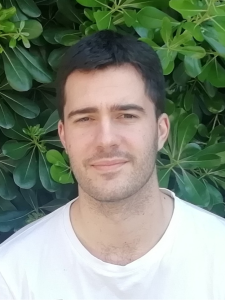 Jaime Paradela Díaz defended his PhD thesis Unstable motions in the Three Body Problem on June 30, 2023.
Jaime Paradela Díaz defended his PhD thesis Unstable motions in the Three Body Problem on June 30, 2023.
The thesis was produced within the UPC doctoral program on Applied Mathematics and his advisors were Marcel Guàrdia and María Teresa Martínez-Seara.
At present he is a Novikov Postdoc at the University of Maryland. His supervisor is Bassam Fayad.
Thesis summary
Broadly speaking, Dynamics aims at understanding the long term behavior of systems for which an infinitesimal evolution rule is known. It was already realized by the French mathematician Henri Poincaré, by the end of the 19th century, that it is in general hopeless trying to give a precise, quantitative description, of all the orbits of a given dynamical system. Instead of trying to solve the differential equations, in his studies of the 3 Body Problem, which models the motion of three bodies interacting via Newtonian gravitation, Poincaré drew attention on a more qualitative picture of the dynamics. One of the main actors in this qualitative description are the hyperbolic periodic orbits of the system. These are periodic orbits for which the linearization of the vector field posseses contracting and expanding directions. Close to the hyperbolic periodic orbits of the system, Poincaré identified mechanisms causing the exponential divergence of nearby orbits. Namely, two arbitrarily close initial conditions can lead, after a sufficiently long time, to quite different behaviors.
Somehow paradoxically, hyperbolicity, although creating local instability, can lead to global stability, in the sense that the whole orbit structure does not change when the system is slightly modified. This was the idea that lead Stephen Smale to introduce in the 1960’s the concept of uniformly hyperbolic systems, in which, at each point of the phase space the local picture of the dynamics resembles that of the dynamics close to a hyperbolic periodic orbit. By now, we have a satisfactory description of the dynamics of uniformly hyperbolic systems. On the other extreme of the spectrum, another class of systems which are well understood are the so called integrable systems. For these systems, the phase space is foliated by invariant submanifolds on which the dynamics resembles that of a linear translation of the torus. This foliation is usually called the Arnold-Liouville foliation. Understanding what happens between these two distant regimes is the goal of the modern theory of dynamical systems. In the last decades, succesful programs have emerged to study what happens at the boundaries of both uniformly hyperbolic and integrable systems.
In this thesis, we present some modest contributions to the understanding of the dynamics of systems close to integrable ones. More concretely, we study the dynamics of the 3 Body Problem (3BP) in a regime where it can be studied as a perturbation of the 2 Body Problem (2BP), which is integrable. In this setting, it is natural to ask what new behavior, not present in 2BP, can appear in the 3 Body Problem.
One of our main results [2] is the existence of topological instability in the restricted 3BP.* Namely, the leaves of the Arnold Liouville foliation of the 2BP are not invariant for the flow of the restricted 3BP, and, we show, there exist orbits of the restricted 3BP connecting arbitrarily far leaves of this foliation.
A second set of results [1, 3] deals with the existence of non trivial hyperbolic sets both in the 3BP and restricted 3BP. Non trivial hyperbolic sets are Cantor like subsets of the phase space where, at each point, the tangent space splits into two complementary uniformly contracting and uniformly expanding subspaces. The dynamics restricted to this set is extremely rich as it displays strong mixing and transitivity.
Although very different in nature, a key ingredient in the proof of both results is the identification of (partially) hyperbolic invariant objects of the phase space of the 3BP. Indeed, we are able to show that the local instability created by these objects can accumulate to induce global changes in the orbit structure when compared to the dynamics of the integrable 2BP, leading to the aforementioned phenomena.
Selected Pre-publication: [1]
References
[1] Marcel Guardia, Pau Martín, Jaime Paradela, and Tere M. Seara, Hyperbolic dynamics and oscillatory motions in the 3 body problem, 2022. arXiv pdf (107 pages).
[2] Marcel Guardia, Jaime Paradela, and Tere M. Seara, A degenerate Arnold diffusion mechanism in the restricted 3 body problem, 2023. arXiv pdf (64 pages).
[3] Jaime Paradela and Susanna Terracini, Oscillatory motions in the restricted 3-body problem: A functional analytic approach, 2022. arXiv pdf (37 pages).